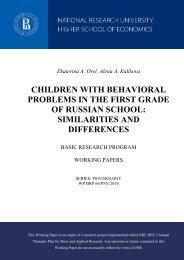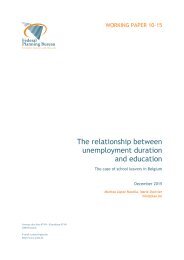Ten-Year Impacts of Burkina Faso’s BRIGHT Program
n?u=RePEc:mpr:mprres:2ecdd42bb503422b802ce20da2bf64b7&r=edu
n?u=RePEc:mpr:mprres:2ecdd42bb503422b802ce20da2bf64b7&r=edu
Create successful ePaper yourself
Turn your PDF publications into a flip-book with our unique Google optimized e-Paper software.
III. IMPLEMENTATION SUMMARY<br />
MATHEMATICA POLICY RESEARCH<br />
Implementation <strong>of</strong> the extension <strong>of</strong> the <strong>BRIGHT</strong> program, <strong>BRIGHT</strong> II, was done in two<br />
phases; we discuss them below.<br />
Phase I (February–December 2009). The main purpose <strong>of</strong> Phase I was to enable <strong>BRIGHT</strong><br />
schools to expand, providing temporary space for 4th-grade classrooms while awaiting<br />
construction <strong>of</strong> the additional classrooms and continuing the interventions begun in <strong>BRIGHT</strong> I.<br />
Plan International communicated with the MEBA to coordinate the temporary classroom<br />
solution, ensuring temporary space and equipment was provided for 4th grades in all <strong>BRIGHT</strong><br />
schools during the first year <strong>of</strong> <strong>BRIGHT</strong> II. MEBA provided tents to be used as temporary<br />
classrooms. In addition, some <strong>of</strong> the more active communities made adjustments to the school<br />
hallways to house the temporary 4th-grade classrooms, building temporary walls with mats or<br />
mud bricks.<br />
CRS continued to provide take-home rations to girls with a monthly attendance <strong>of</strong> 90<br />
percent or higher, as well as daily meals for all schoolchildren at the school canteens and existing<br />
bisongos. FAWE continued the community mobilization and awareness-raising activities on the<br />
importance <strong>of</strong> girls’ education in an effort to increase primary school completion by girls in the<br />
<strong>BRIGHT</strong> villages. These activities aimed to change people’s attitudes toward girls’ education,<br />
address sexual harassment <strong>of</strong> girls, spread awareness <strong>of</strong> the benefits <strong>of</strong> girls’ schooling and the<br />
disadvantages <strong>of</strong> early marriage, and discuss the role <strong>of</strong> women in society. Tin Tua continued to<br />
provide literacy training and educational opportunities to men and women in the <strong>BRIGHT</strong><br />
communities to improve local capacities in literacy/numeracy and income-generating activities,<br />
with the overarching goal <strong>of</strong> strengthening community support for girls’ education. As was done<br />
during <strong>BRIGHT</strong> I, the consortium gave sports equipment—one volleyball net, two volleyballs<br />
and two soccer balls—to <strong>BRIGHT</strong> schools along with classroom equipment and school supplies<br />
(including student desks and textbooks).<br />
Phase II (October 2009–September 2012). Implementation <strong>of</strong> Phase II <strong>of</strong> <strong>BRIGHT</strong> II<br />
consisted <strong>of</strong> constructing the additional school classrooms to house grades 4–6 at existing<br />
<strong>BRIGHT</strong> I schools, as well as additional bisongos, teacher housing, latrines, and boreholes, all<br />
built by Plan International and CRS. All classrooms were designed to provide comfort to the<br />
students, utilizing acoustic and thermal material to reduce noise and excessive heat. The<br />
classroom design remained the same for <strong>BRIGHT</strong> II, except for the elimination <strong>of</strong> a storage<br />
room and director’s <strong>of</strong>fice. The design consists <strong>of</strong> three classrooms, two multi-purpose halls<br />
equipped with blackboards, and ramps to ease access by handicapped persons. Plan International<br />
and CRS also constructed bisongos in the 122 remaining <strong>BRIGHT</strong> villages that did not receive<br />
one during <strong>BRIGHT</strong> I. Plan International and CRS built three additional teacher houses at each<br />
<strong>BRIGHT</strong> school site. The housing design for <strong>BRIGHT</strong> II remained the same as for <strong>BRIGHT</strong> I,<br />
except the <strong>BRIGHT</strong> II houses included a small indoor shower area. In addition to the shower<br />
area, the teacher housing design consists <strong>of</strong> two bedrooms, a living room, a separate kitchen, and<br />
an outdoor latrine. Plan International and CRS also built two additional latrine blocs at the<br />
<strong>BRIGHT</strong> school sites. The latrine design remained the same for <strong>BRIGHT</strong> II: each latrine bloc<br />
consisted <strong>of</strong> a hand-washing station and three stalls, one <strong>of</strong> which had a wheelchair ramp and<br />
wider door for handicapped persons. Plan International and CRS constructed new boreholes and<br />
rehabilitated existing boreholes in <strong>BRIGHT</strong> villages to improve access to water, especially those<br />
that were distant from school grounds.<br />
31







